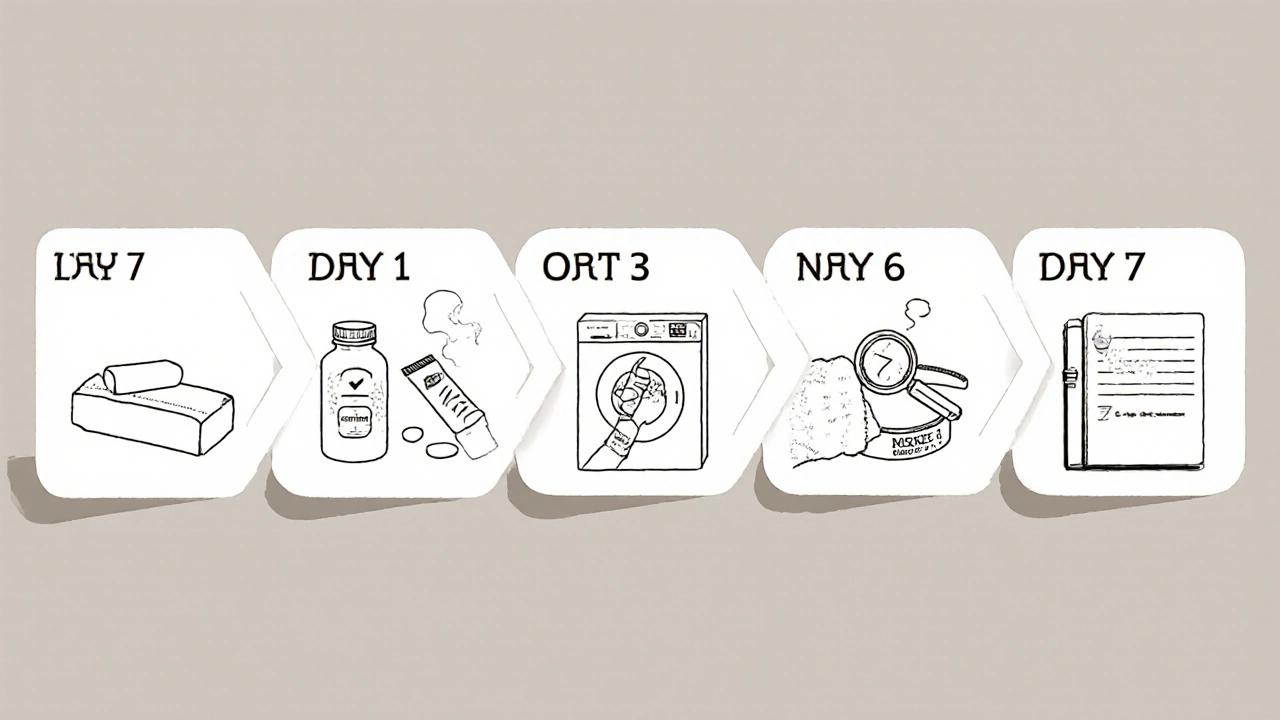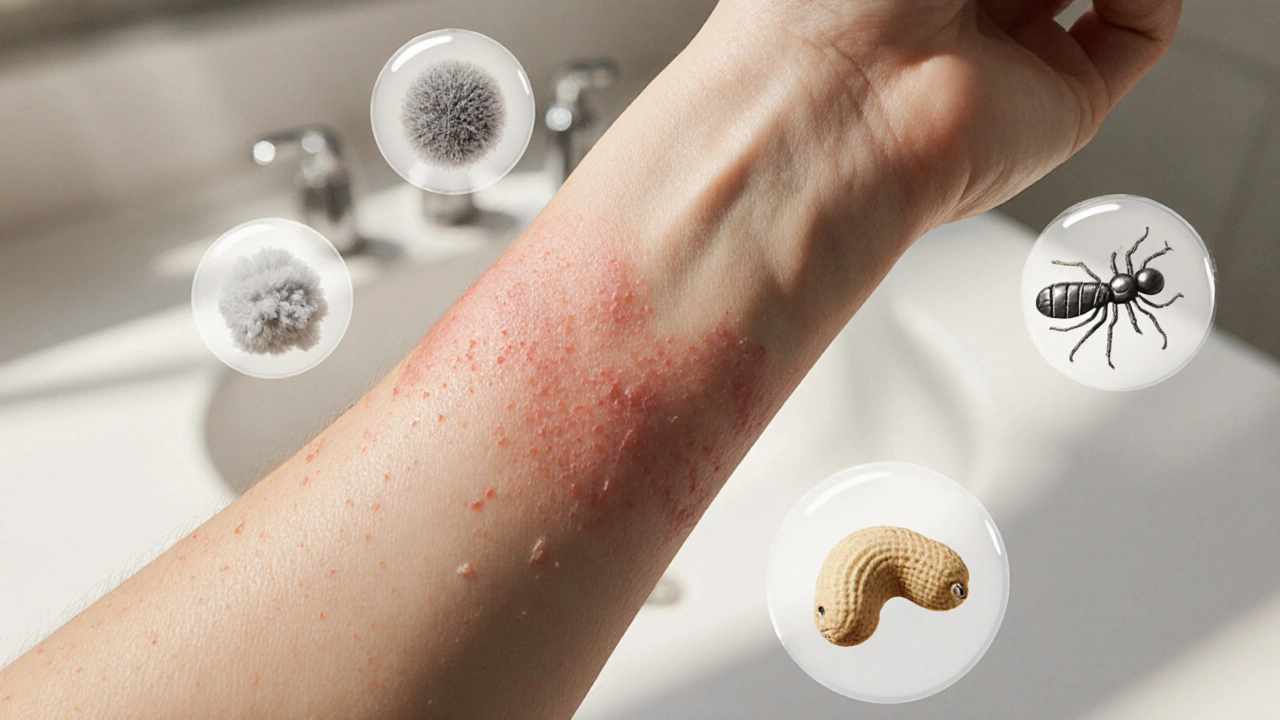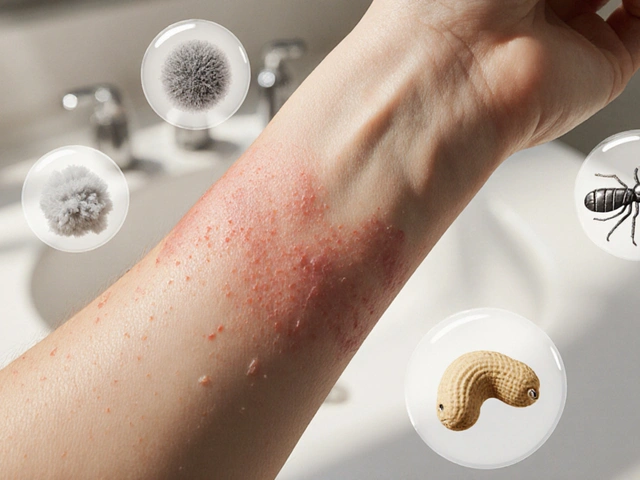Allergy Trigger Tracker & Symptom Journal
Log your first episode to see patterns emerge.
Dealing with relentless itchy skin can feel like a never‑ending battle, especially when you suspect allergies are the culprit but can’t figure out why. In this guide we’ll walk through how to spot the most common triggers, differentiate between allergy‑related itch and other skin woes, and arm you with practical steps to calm the irritation fast.
Key Takeaways
- Identify whether your itch stems from airborne, contact, or food allergens.
- Use a simple symptom‑journal to link flare‑ups with specific exposures.
- Apply proven home‑care routines-cool compresses, fragrance‑free moisturizers, and targeted OTC meds.
- Know the red‑flags that demand a doctor’s visit, such as swelling, breathing trouble, or spreading rash.
- Prevent future episodes by creating an allergy‑safe environment at home and outdoors.
What Exactly Is Itchy Skin? A sensation that compels you to scratch, often caused by inflammation of the skin’s nerve endings.
It’s not just a nuisance-persistent scratching can break the skin, invite infection, and worsen the underlying condition. While stress, dry air, or a bug bite can spark itch, allergies are a leading cause because they trigger the release of chemicals that inflame the cutaneous nerves.
How Allergies Immune system overreactions to otherwise harmless substances. Lead to Itching
When an allergen contacts your body, immune cells release histamine a molecule that expands blood vessels and irritates nerves. The resulting redness, swelling, and itch are the hallmark signs you see on your skin. Different allergens hit different parts of the body, so the pattern of your rash can clue you in on the source.
Common Triggers: Spot the Usual Suspects
Below is a quick cheat‑sheet of the most frequent allergy triggers that cause itch. Use this list when you’re logging your symptoms.
- Environmental allergens: pollen, mold spores, dust mites, pet dander.
- Contact allergens: nickel in jewelry, fragrance in soaps, latex gloves, certain fabrics.
- Food allergens: peanuts, shellfish, dairy, eggs, soy.
- Insect bites: mosquitoes, bed bugs, stinging insects.
- Medications: antibiotics, NSAIDs, certain vaccines.
Even seemingly harmless items like a new laundry detergent can unleash a flare‑up if you’re sensitive to its fragrance or preservatives.
Step‑by‑Step: Building Your Personal Allergy Diary
- Grab a small notebook or a note‑taking app.
- Record the date, time, and location of each itch episode.
- Note everything you ate, wore, and used that day-including skin‑care products and laundry detergent.
- Rate the itch on a 1‑10 scale and describe its appearance (red patches, hives, dry flakes).
- Review the log weekly to spot patterns-maybe the itch spikes on days you run the AC, or after a certain snack.
Consistency is key; missing entries can mask the real trigger. After two weeks of diligent tracking, you’ll likely see a correlation emerge.
When to Call a Professional
Most itchy skin can be managed at home, but watch for these warning signs:
- Rapid swelling of lips, tongue, or face-possible anaphylaxis.
- Difficulty breathing or wheezing.
- Rash that spreads quickly and is painful rather than merely itchy.
- Skin that looks infected-yellow crusts, pus, or fever.
- Chronic itch lasting more than three weeks without clear cause.
If any of these appear, seek medical care immediately. A dermatologist or allergist can run skin‑prick tests, blood work, or patch tests to pinpoint the exact allergen.
Quick‑Fix Relief: What Works Right Now
Below is a comparison of the most common over‑the‑counter (OTC) options for itch relief.
| Product Type | How It Works | Typical Use | Pros | Cons |
|---|---|---|---|---|
| Antihistamines | Block histamine receptors to stop the itch signal. | Oral tablets or liquid, 1‑2 times daily. | Fast systemic relief, helps nighttime itching. | Can cause drowsiness; not ideal for daytime work. |
| Topical Steroids | Reduce local inflammation and immune response. | Apply thin layer 1‑3 times daily to affected area. | Effective for severe flare‑ups, quick symptom drop. | Potential skin thinning with long‑term use. |
| Moisturizers | Replenish skin barrier, lock in hydration. | Apply after bathing, repeat 2‑3 times daily. | Gentle, safe for all ages, prevents dryness. | Doesn’t stop acute histamine‑driven itch. |
| Cooling Gels | Provide a soothing, temperature‑drop effect. | Apply as needed, especially after exposure. | Immediate calming sensation. | Temporary; may contain alcohol that dries skin. |
Start with a fragrance‑free moisturizer to repair the barrier, add an oral antihistamine if the itch is night‑time, and keep a low‑potency topical steroid on hand for sudden flare‑ups.
DIY Soothing Remedies You Can Try at Home
- Oatmeal baths: Blend plain rolled oats into a fine powder, add to lukewarm water, soak for 15 minutes. The avenanthramides in oats calm inflammation.
- Cold compress: Wrap ice in a clean cloth, apply for 5‑10 minutes to numb the area.
- Apple cider vinegar spray: Dilute 1:4 with water, spray on localized hives. Its acidity can reduce the itch, but avoid broken skin.
- Calendula cream: Contains anti‑inflammatory flavonoids, great for mild contact dermatitis.
These options are inexpensive and safe for most people, but discontinue if you notice worsening redness or irritation.

Creating an Allergy‑Friendly Environment
Prevention beats treatment. Here are concrete steps you can adopt:
- Dust‑mite control: Wash bedding weekly in 130°F water, use allergen‑proof covers, keep humidity below 50%.
- Pet management: Groom pets regularly, keep them out of bedrooms, vacuum with HEPA filter.
- Air quality: Use a high‑efficiency air purifier, replace HVAC filters every 3 months.
- Clothing choices: Opt for cotton or bamboo fabrics, avoid wool or synthetic blends that can trap sweat.
- Skin‑care routine: Stick to fragrance‑free cleansers, avoid harsh scrubs, pat skin dry and moisturize within 3 minutes.
Even small tweaks can dramatically lower the frequency of itch episodes.
Special Cases: When Itchy Skin Means Something More
Two skin conditions often masquerade as simple allergy itch but need distinct care.
- Atopic Dermatitis (Eczema): A chronic inflammatory condition that flares with allergens, stress, or dry skin. Look for thickened, scaly patches that may ooze. Management includes regular moisturization, prescription topical steroids, and sometimes phototherapy.
- Contact Dermatitis: Direct irritation from a substance touching the skin (nickel, poison ivy). The rash appears exactly where contact occurred, often with clear borders. The best cure is avoidance and a short course of topical steroids.
Distinguishing these from pure allergic itch helps you apply the right treatment strategy.
Putting It All Together: A Sample 7‑Day Action Plan
- Day 1‑2: Start a symptom diary; switch to fragrance‑free soap and a gentle moisturizer.
- Day 3: Take an OTC antihistamine at night; note any reduction in itch.
- Day 4: Run a hot‑water cycle for bedding; add a hypoallergenic pillow cover.
- Day 5: Perform a quick home test-wear a cotton sleeve on one forearm, a nickel‑containing bracelet on the other for 24hours. Watch for localized redness.
- Day 6: Treat any new rash with a thin layer of 1% hydrocortisone cream.
- Day 7: Review diary entries; identify top three suspected triggers and plan long‑term avoidance.
Follow this routine, adjust based on what you discover, and you’ll see a noticeable drop in itch intensity within a week.
Frequently Asked Questions
Can stress cause itchy skin even without an allergen?
Yes. Stress releases cortisol and other hormones that can disrupt the skin barrier and increase inflammation, making you more prone to itch. Managing stress with meditation, exercise, or adequate sleep can reduce these symptoms.
Are natural remedies like aloe vera as effective as OTC meds?
Aloe vera provides cooling relief and has anti‑inflammatory compounds, but it doesn’t block histamine like antihistamines do. For mild itch it works well; for moderate‑to‑severe allergic reactions, an OTC antihistamine or steroid is usually needed.
How long should I wait before seeing improvement after starting a new moisturizer?
Give the product at least 3‑5 days of consistent use. The skin barrier rebuilds slowly, and you’ll notice reduced dryness and itching after a few applications.
When is it necessary to get an allergy test?
If you can’t pinpoint the trigger after two weeks of diary tracking, or if you experience systemic symptoms (sneezing, wheezing, swelling), schedule a skin‑prick or blood test with an allergist. These tests can identify specific airborne, food, or contact allergens.
Is it safe to use multiple antihistamines together?
Generally no. Combining antihistamines can increase side effects like drowsiness, dry mouth, and heart palpitations. Stick to one recommended dose, or ask a pharmacist if a combination product is appropriate for you.



They’ve hidden the true cause in the chemicals we breathe every day-big pharma knows and silences the itch.
i think thet triger is the new detergnt you used last week i cant beleive
Yo dude, think of that diary like a treasure map-each entry lights up a clue, and before you know it you’ve unlocked the secret to calm skin!
It’s easy to feel overwhelmed when the itch seems relentless, but remember that every small step builds momentum.
Start by committing to log every episode without exception, even the ones you think are insignificant.
Consistency creates a data set that reveals patterns your brain can’t see in the moment.
When you notice a spike after a certain food, treat it as a clue, not a failure.
Replace that trigger with a safe alternative and observe the difference.
Don’t underestimate the power of a fragrance‑free moisturizer; it restores the skin barrier, reducing the itch’s amplification.
Pairing consistent hydration with a nightly antihistamine often calms nocturnal flare‑ups, giving you better sleep.
Sleep, in turn, repairs skin and lowers stress‑driven inflammation, creating a virtuous cycle.
Even the environment matters: a simple air purifier can lower pollen and dust particles that provoke reactions.
Take a weekly snapshot of your bedroom humidity; aim for below 50 % to hinder dust mites.
When you discover a pattern, celebrate the insight-it’s progress, not perfection.
Share your findings with a trusted friend or a support forum; external perspectives often spot angles you missed.
If a pattern remains elusive after two weeks, consider a professional skin‑prick test to uncover hidden allergens.
Remember, the goal isn’t to eliminate all discomfort immediately, but to gradually reduce its frequency and severity.
Your body is signaling, and you’re learning its language step by step.
Stay patient, stay curious, and the itch will lose its power over you.
Alright, keep that log rolling, watch patterns pop, and you’ll have this itch under control in no time!
One could argue the itch narrative is far more nuanced than a mere conspiracy.
Observing the interplay of environmental factors often reveals subtle correlations unnoticed by hurried notes.
🔥🔥 Drama alert! If you skip the oat bath, you’re basically inviting the itch demons to a party! 🎉
Listen up! The best weapon against this torment is relentless logging and a fortress of fragrance‑free armor!
Log it daily 😊.
Our own traditional remedies beat any foreign OTC hack any day.
Oh sure, because centuries of homebrew always trump modern science, right?
Honestly, if you’re not cross‑checking humidity levels daily, you’re missing the biggest trigger.
Interesting how different households handle dust‑mite control; some just vacuum while others seal every crack.
You might consider adding a dehumidifier to that routine for better results.